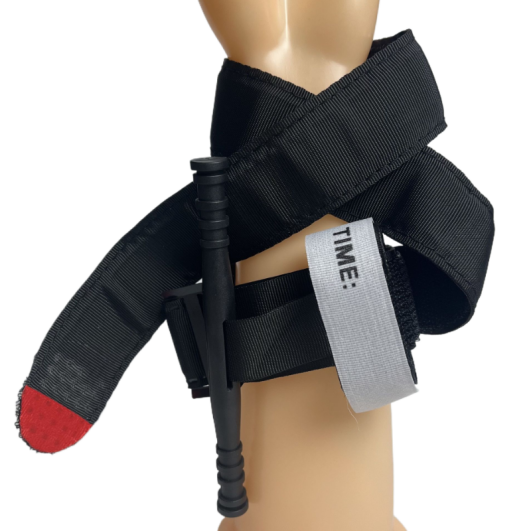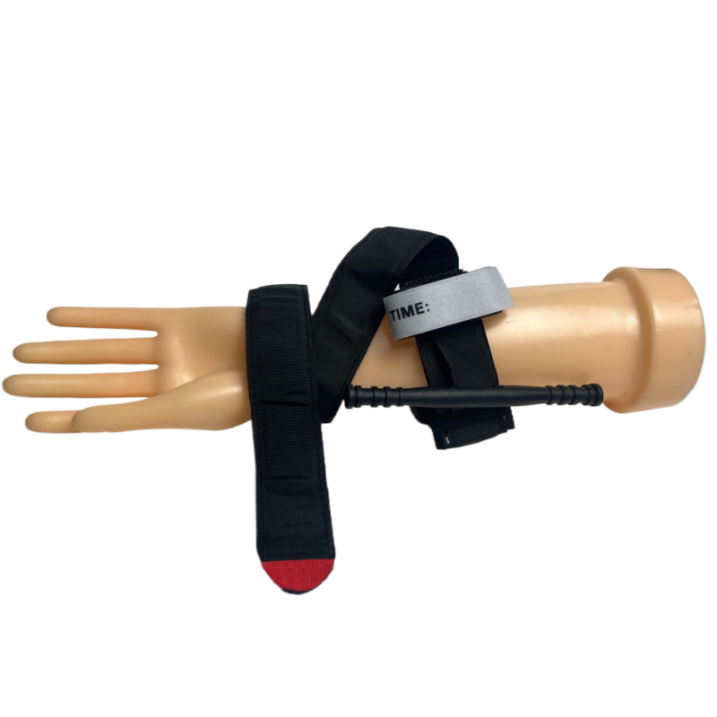War Tactical First Aid Essentials - CAT Tourniquet
2025-02-14
In combat, CAT tourniquets have been widely used, saving the lives of countless soldiers.
CAT tourniquet usually consists of nylon strap, drawstring buckle, velcro, spinning rod, C-shaped locking buckle and other components. This CAT tourniquet has significant advantages, it is easy to operate, stable and reliable hemostatic effect, and easy to carry. When used, it does not need to contact the skin, and can be tied directly to the outside of the clothing sleeve, which greatly improves the convenience of use. The principle of hemostasis is to tighten the nylon self-adhesive tape after fastening, and then tighten it by rotating the twisted rod, so as to achieve the purpose of complete hemostasis. If a single rotating tourniquet does not stop the bleeding effectively, another one can be applied on top of it to ensure complete hemostasis.
CAT tourniquet is a kind of hemostatic tool that can be operated by the injured person himself, the strength is controlled by himself, through the continuous tightening of the strap until the blood stops flowing out, and the tourniquet is buckled in the fixed part of the body to complete the operation process.
The detailed use of tourniquet:
(1) Before applying a tourniquet, the injured limb should be elevated to increase the centripetal return of venous blood and to slow the blood flow.
(2) Quickly remove the tourniquet, open the adhesive tape, apply the tourniquet to the proximal end of the limb about 5 centimeters from the limb wound, and pull the self-adhesive tape tightly and reverse the adhesion. Turn the rotating rod until there is no sign of bleeding at the wound or no arterial pulsation can be felt at the distal end of the limb. Next, snap the swivel bar into the fixation slot and lock the swivel bar and self-adhesive tape with the fixation clasp.
(3) Pay attention to the binding site: for upper limb bleeding, the tourniquet should be tied in the middle and upper third of the upper arm; for lower limb bleeding, the tourniquet should be tied in the near groin of the thigh; the tourniquet should be avoided to be placed in the forearm, calf, elbow joint, knee joint, or pierced parts.
(4) The tourniquet user should promptly and accurately record the start time of tourniquet use.
Precautions for use of CAT tourniquet:
1. Quick access principle: Be sure to place the CAT tourniquet in the backpack and other storage equipment in the position of easy to access, is strictly prohibited to be placed in the bottom of the backpack. It is the first choice for self-help when faced with a bleeding situation in war. Once there is a clear indication of the need to stop bleeding, it should be used without hesitation at the first time, in order to buy golden time for subsequent rescue.
2. Strict indications for use: All personnel on the battlefield should be equipped with professionally recommended spinning tourniquets, as poor quality tourniquets are prone to breakage in extreme environments, and are unable to effectively stop bleeding.
3. Avoid clothing interference: When using a tourniquet, do not turn over or remove clothing such as military uniforms, uniforms, etc., and keep the clothing in its original state in order to accurately determine the location of the bleeding, and to avoid interfering with the judgment of the bleeding point due to the movement of clothing.
4. Handling of special situations: If the bleeding location is difficult to be defined, or the vision is limited during night operation, or the casualty has complicated situations with multiple injuries, the use of tourniquet should follow the principle of “high and tight”, i.e., try to tie it at the end close to the heart (proximal end), to enhance the effect of hemostasis.
5. Multi-tape use norms: If the first tourniquet fails to successfully stop bleeding, a second tourniquet should be quickly added at the proximal (upper) end of the heart. Special attention should be paid to ensure that the stranded rods of the two tourniquets do not interfere with each other, so as not to affect the hemostatic effect.
6. Joint contraindication: when tying the tourniquet, avoid crossing the knee or elbow joint. Because of the special anatomical structure of these joints, a tourniquet across here will easily lead to poor hemostatic effect and cannot effectively stop bleeding.
7. Monitoring the status of the casualty: After applying tourniquet, it is necessary to closely monitor the vital signs and bleeding status of the casualty to ensure that the pressure of the tourniquet is sufficiently tight and the bleeding is effectively controlled, and make timely adjustments once any abnormality is found.
8. Repeated assessment requirements: after applying any tourniquet, it is necessary to establish the awareness of repeated assessment. Uninterruptedly assess the effect of hemostasis, the condition of the injured limb, etc., and promptly adjust the use of tourniquet or take other necessary treatment measures according to the assessment results.
CAT tourniquet is easy to operate, fast and effective in stopping bleeding, and has become the favorite of soldiers on the battlefield! Compared with the traditional gauze hemostatic bandage, it has two characteristics, firstly, it is fast and can achieve hemostatic effect in a few seconds; secondly, it can be operated by a single soldier, even without the help of comrades or medics, it can also quickly stop the bleeding for themselves.






